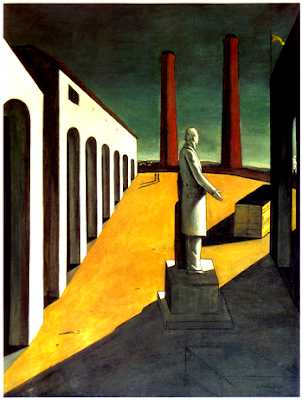By Brian George
Below, you will find the revised and expanded version of a comment that I posted yesterday on the Reality Sandwich forum for Joscelyn Godwin's "Atlantis and the Cycles of Time." This article prompted me to go more deeply into a concept that I've been exploring--that of "the infinite recession of a landscape." As so often happens, the almost accidental comment locked into the structure of a larger project--as though the project somehow existed in an already complete form in the future, and the individual parts had to be retroactively filled in.
The short post has now turned into a mini-essay, and I have decided to use it as section five of "The Vanguard of a Perpetual Revolution." The old section five has now become section six. With the introductory comments to Joscelyn removed, the piece now reads:
(The Vanguard of a Perpetual Revolution/ Part 5)
The Infinite Recession of a Landscape
"These, your family, are already dust, and so press on in the fight."—Krishna to Arjuna on the field of Kurukshetra
__
From the age of 18 or so I have been convinced that human history was far older than the mainstream model would allow, and I have felt and known this with a kind of physical certainty—as though a respected academic had informed me that there were no such thing as “Feet,” but I knew, from my own experience, that there were. Details were somewhat out of focus, however; to bring the image into focus I eagerly sought out books on “Atlantis.” For the most part, I was very disappointed.
I kept looking for new ancient source material, as well as for fresh archeological research, but it seemed as though writers were only quoting other writers, and then going on to improvise their own set of variations upon a set of established themes.
More recently, however, I believe that we may be moving into a more mature understanding of “Atlantis”—a word that I most often go out of my way not to use. If you were to substitute the phrase “world seafaring culture” for “forest” and the word “culture” for “trees,” then the problem has perhaps been one of “not seeing the forest for the trees.” Quite simply, it is possible that we have dramatically underestimated the vast breadth and depth of human history. Surrounded by the almost infinite recession of a landscape that seems too overwhelming to even begin to comprehend—or rather would if some past trauma had not struck us almost blind—we allow ourselves to become fixated on each individual tree.
So too, with each new discovery, this or that culture comes to occupy the foreground of our attention.
We jump for joy to discover that a certain city has been laid out in three rings, through which run canals in the shape of a cross—as described by Plato. It does not occur to us that we are looking at an image of the Bindu, as projected onto a horizontal stage and then activated by the turning of the four cardinal signs of the Zodiac.
Or that this city is only one out of an intercontinental network of such sites—sites towards which the Ancients have directed us with arrows, whose locations they marked with megalithic blocks, and which they were so inconsiderate as to have hidden beneath our noses! We are, perhaps, as ignorant as we had feared, and begin to suspect that Evolution—although true—is a process that might be running in reverse.
Still, it is necessary for each nearsighted vagrant to start somewhere—as he chooses which culture is to occupy the foreground. He is young, and has forgotten what he knew as an adult. Fear magnifies each detail in the foreground. No megalithic complex is so large that he is not free to ignore it, and no thumbnail held in the foreground is so small that it cannot blot out his vision of the whole.
Signs point to the infinite recession of a landscape—within whose depths float the cities where we lived. It is the work of many lifetimes to forget where we are from, how truly strange we are, and to what cultures we have given birth.
It is as though, in 10,000 years, we were to read about the sinking of Los Angeles, the greater part of which, in a single day, had disappeared into the “San Andreas Fault,” along with all of its rumored high technology. Following up on an accidental discovery by a shepherd, archeologists then begin to excavate the coastal remains of London, and announce with much fanfare to the world, “Eurika! We have found LA!” Meanwhile, another group of archeologists is just starting to excavate Tokyo.
This sense of “the infinite recession of a landscape” is one that I have played with in a number of poems and essays. To say “the infinite recession of a landscape” does not exactly call up an image, although it could certainly be translated into one. It could just as easily be understood as a concept—a concept that subverts any clear interpretation. Then too, this concept could also be experienced as a memory. Myths grow into cities which then roll into oceans. Oceans heave themselves into the constellations, and beyond, to where the Ancients watch.
Vista upon vista, archaic in the opaque formality of its signs, the landscape opens onto the depths of the nonexistent, and then further sinks from view.
Poem one from my book “Maps of the Metaphysical Double; In the Footprints of de Chirico” ends: “The records from that period are blank. The shadow of a leaf—enormous—floats. Prehistoric observatories echo under strata. Giants fossilized in pots. The trees crooked—with foreign roots. Birds that never came.”
(Illustration: Giorgio de Chirico, The Enigma of a Day, 1914)


No comments:
Post a Comment